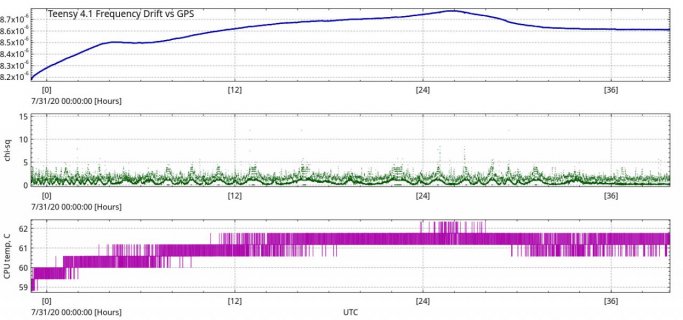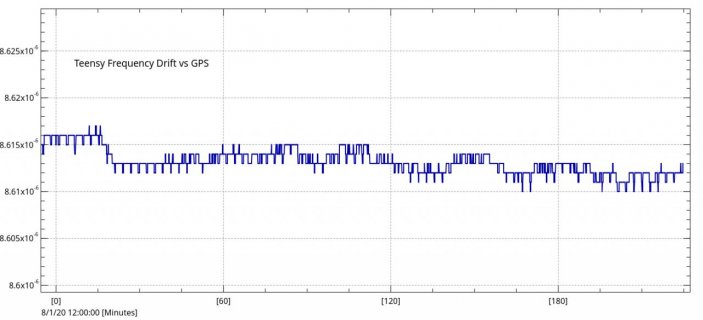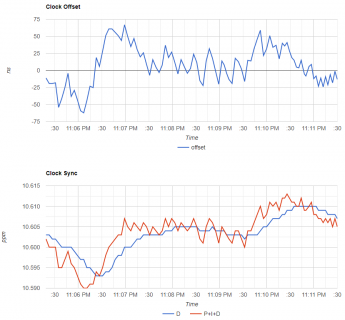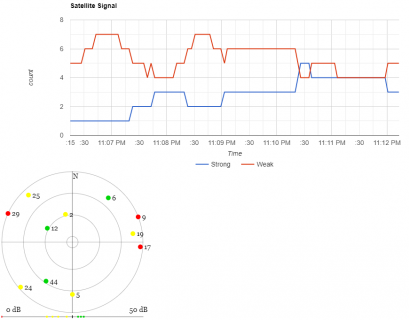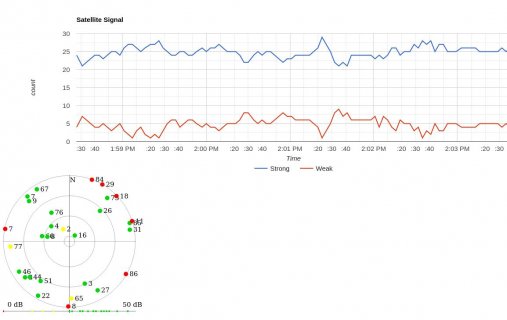With more data, I see my wild surmise about my GPSDO was wrong, and your more obvious suggestion was correct. Almost all the variation I saw was explained by air movement over the T4.1 PCB, as well as the ambient temperature. When I left the office with the door closed overnight, the error was a mostly a regular low-pass-filtered square wave tracking the 23-minute HVAC on/off cycle. This morning, after I sealed the T4.1 into an 8 inch cinderblock to remove drafts and stabilize its temperature, the chi-squared value is often less than 1 and rarely exceeds 5, and the offset rarely exceeds 30 ns, so the performance is quite different from before.
Code:
count offset frequency chisq ppb ntpseconds
1723630418 0.000000013 0.000007707 0.333104610 7708 3805121064
1798629840 0.000000009 0.000007707 0.333148301 7707 3805121067
1823629647 0.000000023 0.000007707 0.638458192 7709 3805121068
1898629069 0.000000020 0.000007707 0.305683136 7709 3805121071
1998628298 0.000000026 0.000007707 0.437653899 7710 3805121075
2073627720 0.000000018 0.000007708 0.405045867 7709 3805121078
2148627142 0.000000010 0.000007708 0.337020397 7709 3805121081
2248626371 0.000000016 0.000007708 0.325883627 7709 3805121085
2323625793 0.000000010 0.000007708 0.257352889 7709 3805121088
2348625600 0.000000022 0.000007708 0.275229812 7710 3805121089
2423625022 0.000000014 0.000007708 0.226483017 7709 3805121092
2523624251 0.000000017 0.000007708 0.229082704 7710 3805121096
2598623673 0.000000010 0.000007709 0.233526707 7709 3805121099
2698622902 0.000000014 0.000007709 0.233599454 7710 3805121103
2723622709 0.000000024 0.000007709 0.321402192 7711 3805121104
2823621938 0.000000023 0.000007709 0.375832856 7711 3805121108
2898621360 0.000000010 0.000007709 0.377925456 7710 3805121111
2998620589 0.000000010 0.000007709 0.421401381 7710 3805121115
3023620396 0.000000020 0.000007709 0.451219887 7711 3805121116
3123619625 0.000000020 0.000007710 0.515136003 7711 3805121120
3198619047 0.000000007 0.000007710 0.347284496 7710 3805121123
3298618276 0.000000007 0.000007710 0.274755895 7710 3805121127
3323618083 0.000000017 0.000007710 0.437681466 7712 3805121128
3423617312 0.000000014 0.000007710 0.339892298 7711 3805121132
3523616541 0.000000010 0.000007710 0.339898229 7711 3805121136
Last edited:


